Related Research Articles
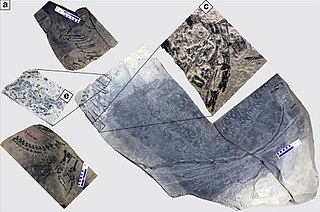
Dinocephalosaurus is a genus of long necked, aquatic protorosaur that inhabited the Triassic seas of China. The genus contains the type and only known species, D. orientalis, which was named by Li in 2003. Unlike other long-necked protorosaurs, Dinocephalosaurus convergently evolved a long neck not through elongation of individual cervical vertebrae, but through the addition of cervical vertebrae that each have a moderate length. Like other tanystropheids, however, Dinocephalosaurus probably used its long neck to hunt for prey, utilizing a combination of suction, created by the expansion of the throat, and the fang-like teeth of the jaws to ensnare prey. It was probably a marine animal by necessity, as suggested by the poorly-ossified and paddle-like limbs which would have prevented it from going ashore.
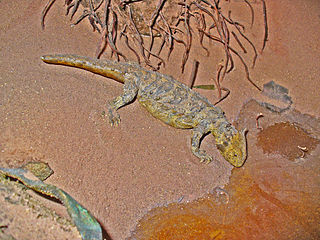
Procolophonidae is an extinct family of parareptiles from the Permian and Triassic periods.
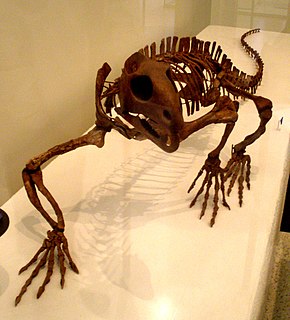
Trilophosaurus is a lizard-like trilophosaurid allokotosaur known from the Late Triassic of North America. It was a herbivore up to 2.5 m long. It had a short, unusually heavily built skull, equipped with massive, broad flattened cheek teeth with sharp shearing surfaces for cutting up tough plant material. Teeth are absent from the premaxilla and front of the lower jaw, which in life were probably equipped with a horny beak.

Mecistotrachelos is an extinct genus of gliding reptile believed to be an archosauromorph, distantly related to crocodylians and dinosaurs. The type and only known species is M. apeoros. This specific name translates to "soaring longest neck", in reference to its gliding habits and long neck. This superficially lizard-like animal was able to spread its lengthened ribs and glide on wing-like membranes. Mecistotrachelos had a much longer neck than other gliding reptiles of the Triassic such as Icarosaurus and Kuehneosaurus. It was probably an arboreal insectivore.
Hans-Dieter Sues is a German-born American paleontologist who is Senior Scientist and Curator of Vertebrate Paleontology at the National Museum of Natural History of the Smithsonian Institution in Washington, DC.

Robert Rafael Reisz is a Canadian paleontologist and specialist in the study of early amniote and tetrapod evolution.

Macrocnemus is an extinct genus of archosauromorph reptile known from the Middle Triassic of Europe and China. Macrocnemus is a member of the Tanystropheidae family and includes three species. Macrocnemus bassanii, the first species to be named and described, is known from the Besano Formation and adjacent paleontological sites in the Italian and Swiss Alps. Macrocnemus fuyuanensis, on the other hand, is known from the Falang Formation in southern China. A third species, Macrocnemus obristi, is known from the Prosanto Formation of Switzerland and is characterized by gracile limbs. The name Macrocnemus is Greek for "long tibia".

Cyclotosaurus is an extinct genus of temnospondyl within the family Mastodonsauridae. It was of great size for an amphibian, reaching 3–4.3 m (9.8–14.1 ft) in length with an elongated 70 cm (28 in) skull.

Brachyrhinodon is an extinct genus of sphenodontian from the Late Triassic Lossiemouth Sandstone of Scotland. It is related to the tuatara, the only member of its order that is not extinct.
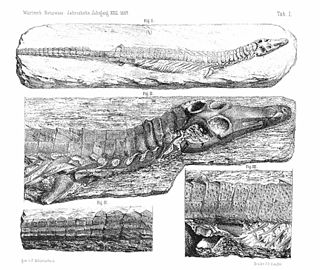
Dyoplax is an extinct genus of pseudosuchian archosaur, possibly an erpetosuchid. Fossils have been found from the type locality within the upper Schilfsandstein Formation in Stuttgart, Germany. The holotype specimen was a natural cast of a nearly complete skeleton that lacked only parts of the tail and limb bones.
Uatchitodon is an extinct genus of Late Triassic reptile known only from isolated teeth. Based on the structure of the teeth, Uatchitodon was probably a carnivorous archosauromorph. Folded grooves on the teeth indicate that the animal was likely venomous, with the grooves being channels for salivary venom. The teeth are similar to those of living venomous squamates such as Heloderma and venomous snakes. Uatchitodon is the earliest known venomous reptile.
Tricuspisaurus is an extinct genus of reptile originally described as a trilophosaurid; it was later considered likely to be a procolophonid, but recent analyses have affirmed the original classification. Fossils are known from the Ruthin Quarry in Glamorgan, Wales, one of several Late Triassic to Early Jurassic British fissure deposits. Like some trilophosaurs, it has an edentulous, or toothless beak. Tricuspisaurus gets its name from its heterodont dentition, which includes tricuspid teeth, or teeth with three cusps. The type species, T. thomasi, was named in 1957 along with the possible trilophosaur Variodens inopinatus from Somerset, England.

Protorosauria is an extinct, possibly polyphyletic, group of archosauromorph reptiles from the late Permian to the start of the Late Triassic of Asia, Europe, North America. It was named by the English anatomist and paleontologist Thomas Henry Huxley in 1871 as an order. Other names which were once considered equivalent to Protorosauria include Prolacertiformes and Prolacertilia.
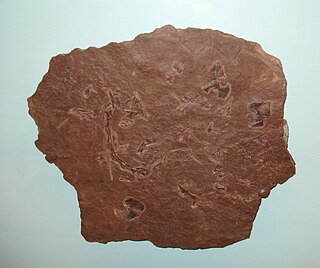
Amotosaurus is an extinct genus of tanystropheid protorosaur from the earliest Middle Triassic of Black Forest, southwestern Germany. Amotosaurus is known from the holotype SMNS 50830, a partial skeleton including left maxilla with teeth, cervical series, pelvic girdle and other postcranial remains. Other specimens include SMNS 90600-90601, SMNS 50691, SMNS 54783a-b and SMNS 54810. It was first described and named by Nicholas C. Fraser and Olivier Rieppel in 2006 and the type species is Amotosaurus rotfeldensis.

Tanystropheidae is an extinct family of mostly marine archosauromorph reptiles that lived throughout the Triassic Period. They are characterized by their long, stiff necks formed from elongated cervical vertebrae with very long cervical ribs. Some tanystropheids such as Tanystropheus had necks that were several meters long, longer than the rest of their bodies.
Fuyuansaurus is an extinct genus of "protorosaur" reptiles known from the Middle Triassic Falang Formation of southern China. Fuyuansaurus was first named by Nicholas C. Fraser, Olivier Rieppel and Li Chun in 2013 and the type species is Fuyuansaurus acutirostris.

The Röt Formation or Rötton Formation is a geologic formation of the Buntsandstein in Germany. It preserves fossils dating back to the Middle Triassic period. The formation overlies the Plattenstein and Solling Formations and is overlain by the Jena Formation.
Pectodens is an extinct genus of archosauromorph reptile which lived during the Middle Triassic in China. The type and only species of the genus is P. zhenyuensis, named by Chun Li and colleagues in 2017. It may be a member of the Protorosauria; an unusual combination of traits similar and dissimilar to other members causes Pectodens to elude exact classification.
Oryctorhynchus is an extinct genus of rhynchosaur from the Late Triassic (Carnian-Norian)-aged Wolfville Formation of Nova Scotia, Canada. The type species, O. bairdi, was named and described in 2020. It was originally seen as a species of Hyperodapedon until 2020.
References
- 1 2 3 4 5 6 7 8 9 10 11 12 "FRASER, Dr Nicholas Campbell". Who's Who 2016. Oxford University Press. November 2015. Retrieved 14 January 2016.
- 1 2 3 4 5 6 7 "Dr Nick Fraser". National Museums Scotland. Retrieved 14 January 2016.
- ↑ "Nicholas C. Fraser". Department of Geosciences. Virginia Tech. Retrieved 14 January 2016.
- ↑ "Adjunct Researchers". Virginia Museum of Natural History. Retrieved 14 January 2016.
- 1 2 "Dr Nick Fraser". TW:eed Project. Retrieved 14 January 2016.
- ↑ Fraser, N. C.; Rieppel, O. (2006). "A new protorosaur (Diapsida) from the Upper Buntsandstein of the Black Forest, Germany". Journal of Vertebrate Paleontology. 26 (4): 866. doi:10.1671/0272-4634(2006)26[866:ANPDFT]2.0.CO;2.
- ↑ Fraser, N. C.; Rieppel, O.; Chun, L. (2013). "A long-snouted protorosaur from the Middle Triassic of southern China". Journal of Vertebrate Paleontology. 33 (5): 1120. doi:10.1080/02724634.2013.764310.
- ↑ Dooley, Alton C.; Fraser, Nicholas C.; Luo, Zhe-Xi (2004). "The earliest known member of the rorqual—gray whale clade (Mammalia, Cetacea)". Journal of Vertebrate Paleontology. 24 (2): 453–463. doi:10.1671/2401.